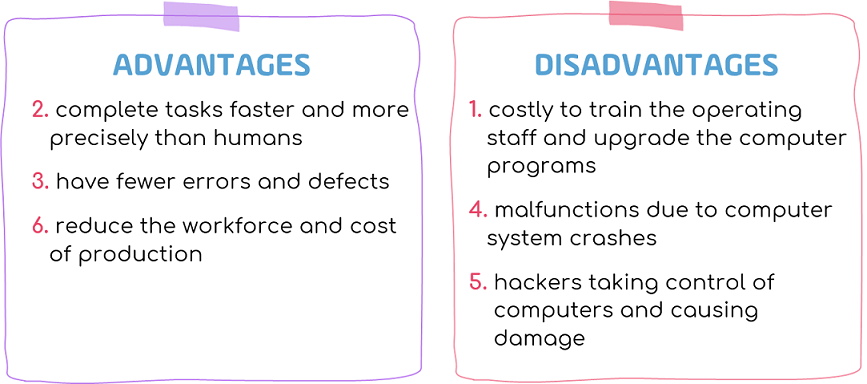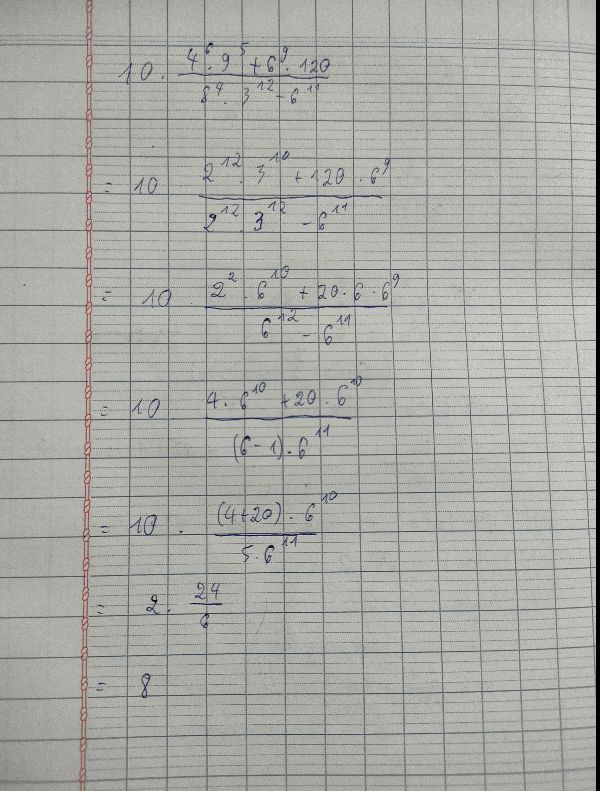Tìm a biết a + a + a +1/2 * 2/5 + a +8/10 + a = 136
Hãy nhập câu hỏi của bạn vào đây, nếu là tài khoản VIP, bạn sẽ được ưu tiên trả lời.


Intelligent Robots play a vital role in modern days. Besides benefits, we must consider disadvantages when using them.
First, look at the most positive points. Thanks to robots and A.I technology, the number of workforce can be reduced but the production even increases more, especially in the manufacturing industry. The robots can perform the tasks faster than the humans and much more consistently and accurately. They can work at places 24/7 without any salary and food. Additionally, they don’t get bored. In medicine, they helps doctors to diagnose diseases, do the surgeries, especially tiny surgeries with highest accuracy. In some hospitals, the robo pets can help the patients with depression and they keep them active.
On the contrary, robots bring about some troubles. First and for most, training is needed to operate the system, so we need to pay for scientists and trainees, maintenance and reparation expenditure, which raise the cost overall. Another point I’d to mention is the machine malfunction, which creates lots of troubles and confusions, and even sometimes lead to unexpected accidents. It’s reported that a robot in a car manufacturing factory killed a worker. This results in a worrisome of people using A.I for medical purposes. Furthermore, the robots are not able to act any different from what they are programmed to do. With the heavy application of robots, the humans may become overly dependent on the machines, losing their mental capacities. If the control of robots goes in the wrong hands, the robots may cause the destruction.
In conclusion, I suppose that we need to take advantages of A.I to make our life better, but remember its dangers and risks to take precaution timely.
Dịch:
Robot thông minh đóng một vai trò quan trọng trong thời hiện đại ngày nay. Ngoài lợi ích, chúng ta phải xem xét những bất lợi khi sử dụng chúng.
Trước tiên, hãy nhìn vào những điểm tích cực nhất. Nhờ robot và công nghệ A.I, số lượng lao động có thể giảm xuống nhưng năng suất thậm chí còn tăng nhiều hơn, đặc biệt là trong ngành chế tạo. Các robot có thể thực hiện các nhiệm vụ nhanh hơn con người và hơn nữa một cách nhất quán và chính xác. Chúng có thể làm việc tại các địa điểm 24/7 mà không cần có lương hay thực ăn. Ngoài ra, chúng không cảm thấy buồn chán. Trong y học, chúng giúp các bác sĩ chẩn đoán bệnh tật, phẫu thuật, đặc biệt là các tiểu phẫu với độ chính xác cao nhất. Ở một số bệnh viện, thú nuôi robot có thể giúp bệnh nhân trầm cảm và giữ họ hoạt động.
Ngược lại, robot tạo ra một số rắc rối. Đầu tiên nhất, đào tạo là cần thiết để vận hành hệ thống, do đó chúng ta cần phải trả cho các nhà khoa học và học viên, chi phí bảo dưỡng và sửa chữa, làm tăng chi phí tổng thể. Một điểm tôi muốn đề cập đến là sự cố máy móc, tạo ra nhiều rắc rối, và thậm chí đôi khi dẫn đến những tai nạn không ngờ đến. Đã được ghi nhận rằng một robot trong một nhà máy sản xuất xe hơi giết chết một công nhân. Điều này dẫn đến một sự đáng lo ngại của người sử dụng A.I cho mục đích y tế. Hơn nữa, các robot không thể hành động khác với những gì chúng được lập trình để làm. Với việc ứng dụng nhiều robot, con người có thể trở nên quá phụ thuộc vào máy móc, mất khả năng tinh thần của họ. Nếu sự kiểm soát của robot đi sai hướng, các robot có thể gây ra sự phá hủy.
Tóm lại, tôi cho rằng chúng ta cần tận dụng lợi thế của A.I để làm cho cuộc sống của chúng ta tốt hơn, nhưng hãy nhớ đến những nguy cơ và rủi ro của nó để kịp thời phòng ngừa.
You can use this to refer:
Intelligent Robots play a vital role in modern days. Besides benefits, we must consider disadvantages when using them.
First, look at the most positive points. Thanks to robots and A.I technology, the number of workforce can be reduced but the production even increases more, especially in the manufacturing industry. The robots can perform the tasks faster than the humans and much more consistently and accurately. They can work at places 24/7 without any salary and food. Additionally, they don’t get bored. In medicine, they helps doctors to diagnose diseases, do the surgeries, especially tiny surgeries with highest accuracy. In some hospitals, the robo pets can help the patients with depression and they keep them active.
On the contrary, robots bring about some troubles. First and for most, training is needed to operate the system, so we need to pay for scientists and trainees, maintenance and reparation expenditure, which raise the cost overall. Another point I’d to mention is the machine malfunction, which creates lots of troubles and confusions, and even sometimes lead to unexpected accidents. It’s reported that a robot in a car manufacturing factory killed a worker. This results in a worrisome of people using A.I for medical purposes. Furthermore, the robots are not able to act any different from what they are programmed to do. With the heavy application of robots, the humans may become overly dependent on the machines, losing their mental capacities. If the control of robots goes in the wrong hands, the robots may cause the destruction.
In conclusion, I suppose that we need to take advantages of A.I to make our life better, but remember its dangers and risks to take precaution timely.

\(A=\left\{0;2;4;6;8;10:12;14;16;18\right\}\)
\(B=\left\{0;3;6;9;12;15;18\right\}\)
\(C=\left\{0;6;12;18\right\}\)


Gọi số đó là a.
a : 7 dư 5.
a : 13 dư 4.
=> a + 9 chia hết cho 7 và 13.
7 và 13 đều là số nguyên tố => a + 9 chia hết cho 7 x 13 = 91.
=> a chia cho 91 dư 91 - 9 = 82.
Vây số đó chia 91 dư 82.
Số nhỏ nhất chia 7 dư 4 và chia 13 cũng dư 4 là :(7x13)+4=95
Vậy số a chia 91 dư :95:91=1(dư 4)
Vậy số a chia 91 dư 4

c) hang dang thuc ( x -y+z)^2
o duoi phan h hang dang thuc luon
a) phan h nhan tu ra sao cho co tử la (x-1)(3x^2 -4x +1)
mau la (x-1)(2x^2 -x-3)
b ) k nhin dc de

Bài 2 , 3 mình đang suy nghĩ Làm tạm mấy bài sau trc.
Bài 4:
+) n4 co tận cùng là 1 , 6 , 5 => n8 - n4 chia hết cho 10 ( 1 )
+) n8 - n4 = n2 (n - 1 )( n + 1 )( n2 + 1 ) chia hết cho 3 và 4 ( 2 )
Từ ( 1 ) và ( 2 ) => ĐPCM
Bài 5 :
\(A=2005^n+60^n-1897^n-168^n\)
Ta có :
+) \(\hept{\begin{cases}2005^n\equiv1\left(mod4\right)\\1897^n\equiv1\left(mod4\right)\end{cases}}\)
\(\Rightarrow A\equiv1+0-1+0=0\left(mod4\right)\)
\(\Rightarrow A⋮4\)
+) \(\hept{\begin{cases}2005^n\equiv1\left(mod3\right)\\1897^n\equiv1\left(mod3\right)\end{cases}}\)
\(\Rightarrow A\equiv1+0-1+0=0\left(mod3\right)\)
\(\Rightarrow A⋮3\)
+) \(\hept{\begin{cases}2005^n\equiv1\left(mod167\right)\\1897^n\equiv1\left(mod167\right)\\168^n\equiv\left(mod167\right)\end{cases}}\)
\(\Rightarrow A\equiv1+60^n-60^n-1=0\left(mod167\right)\)
\(\Rightarrow A⋮2004\)
Bài 6 :
\(6^{2n}+19^n-2^{n-1}\)
\(=36^n+19^n-2.2^n\)
\(=\left(36^n-2^n\right)+\left(19^n-2^n\right)\)
Ta có : \(\hept{\begin{cases}36^n-2^n⋮34\\19^n-2^n⋮17\end{cases}\Rightarrow}6^{2n}+19^n-2^{n-1}\)

-gọi giá bút chì màu là x
-gọi giá bút chì đen là y
ta có : 5x+3y=5100 (1)
5x - 2y =1600 (2)
(1) - (2) : 5x + 3y - (5x - 2y) = 5100-1600
5x + 3y - 5x + 2y = 3500
5y = 3500
y=700
thay y= 700 vào (2) : 5x- 2.700=1600
5x=1600+1400
5x=3000
x=600
==>bút chì mầu giá 600/cái
bút chì đen giá 700/cái

Số gạo của thùng C sau khi đổ sang thùng A là:
\(18\div\left(1-\frac{1}{10}\right)=20\left(kg\right)\)
Thùng C đổ sang thùng A số gạo là:
\(20-18=2\left(kg\right)\)
Thùng A ban đầu có số gạo là:
\(\left(18-2\right)\div\left(1-\frac{1}{3}\right)=24\left(kg\right)\)
Thùng A đổ sang thùng B số gạo là:
\(24\times\frac{1}{3}=8\left(kg\right)\)
Tổng số gạo của cả ba thùng là:
\(18\times3=54\left(kg\right)\)
Số gạo của thùng B trước khi đổ sang thùng C là:
\(18\div\left(1-\frac{1}{4}\right)=24\left(kg\right)\)
Thùng B ban đầu chứa số gạo là:
\(24-8=16\left(kg\right)\)
Thùng C ban đầu chứa số gạo là:
\(54-24-16=14\left(kg\right)\)
Phân số chỉ 18 kg là :
\(1-\frac{1}{10}=\frac{9}{10}\) ( số gạo thùng C )
Số gạo của thùng C sau khi chuyển \(\frac{1}{10}\)số gạo sang thùng A là :
\(18\div\frac{9}{10}=20\)( kg )
Số gạo chuyển sang thùng A là :
\(20-18=2\)( kg )
Số gạo của thùng A sau khi chuyển \(\frac{1}{4}\)số gạo sang thùng B là :
\(18-2=16\)( kg )
Phân số chỉ 16 kg là :
\(1-\frac{1}{3}=\frac{2}{3}\)( số gạo thùng A )
Số gạo thùng A lúc đầu là :
\(16\div\frac{2}{3}=24\)( kg )
Thùng A chuyển cho thùng B số kg là :
\(24\times\frac{1}{3}=8\)( kg )
Số gạo của thùng B sau khi chuyển \(\frac{1}{4}\)số gạo sang thùng C là :
\(1-\frac{1}{4}=\frac{3}{4}\)( số gạo thùng B )
Số gạo thùng B là :
\(18\div\frac{3}{4}=24\)( kg )
Số gạo thùng B chuyển sang thùng C là :
\(24\times\frac{1}{4}=6\)( kg )
Số gạo thùng C là :
\(20-6=14\)( kg )




Ta có : \(a+a+a+\frac{1}{2}.\frac{2}{5}+a+\frac{8}{10}+a=136\)
\(\Leftrightarrow5a+\frac{1}{2}.\frac{2}{5}+\frac{8}{10}=136\)
\(\Leftrightarrow5a+\frac{1}{5}+\frac{8}{10}=136\)
\(\Leftrightarrow5a+1=136\)
\(\Leftrightarrow5a=135\)
\(\Leftrightarrow a=27\)
Vậy \(a=27\)
a + a + a + 1/2 . 2/5 + a + 8/10 + a = 136
=> a + a + a + a + a + 1/2 . 2/5 + 4/5 = 136
=> 5a + 1/5 + 4/5 = 136
=> 5a + 1 = 136
=> 5a = 136 - 1
=> 5a = 135
=> a = 135 : 5
=> a = 27